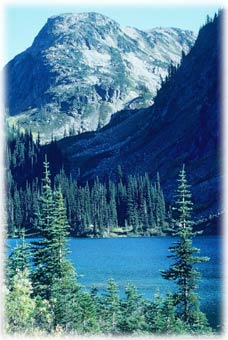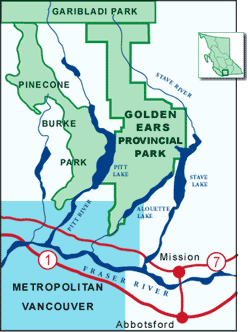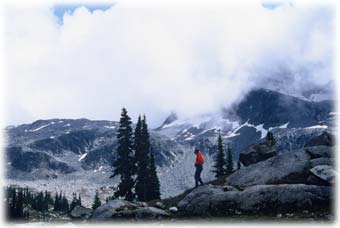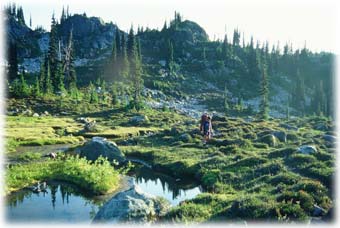|
|
|
|
|
|

Situated close enough to Vancouver to be a favoured location for urban day and weekend visitors, Golden Ears Parks is named for Mount Blanchard's twin peaks. Seen in bright sun these intriguing peaks seem to glow gold. This park is popular with a broad range of visitors since it offers such a wide variety of recreational opportunities. The park's sparkling lakes, lush forests, and rugged mountains make it excellent for hiking, boating, wildlife viewing, camping, picnicking, and swimming. As well, this 55,590 hectare (137,368 acre) park is ecologically important both because of its location close to the urbanised Lower Mainland, and its large size.
|

Golden Ears Park is located close to Vancouver, making it an easy and popular park to visit. Access to the park is by car. For those coming from Vancouver travel the short distance east to Maple Ridge (located on the north side of the Fraser River) and from there drive 11km along Highway 7, where there are signs marking the entrance to the park. Coming from elsewhere in BC, travellers should head west towards Vancouver, follow signs to Maple Ridge and continue from there as described above.

Click on the map to view an enlargement
|
|
"The park's sparkling lakes, lush forests, and rugged mountains mean that Golden Ears Park is excellent for hiking, boating, wildlife viewing, camping, picnicking, and swimming."
|

 Visitors to Golden Ears Park have a wide variety of recreational opportunities to choose from. There are vehicle accessible campsite at Gold Creek, Alouette Lake and North Beach. To book sites in advance, BC Parks provides a reservation system at all 3 campsites during busy seasons. There are also 2 group campsites available for reservation through BC Parks. Back country and walk in camping is permitted at several locations within the park, but no facilities are provided. Visitors to Golden Ears Park have a wide variety of recreational opportunities to choose from. There are vehicle accessible campsite at Gold Creek, Alouette Lake and North Beach. To book sites in advance, BC Parks provides a reservation system at all 3 campsites during busy seasons. There are also 2 group campsites available for reservation through BC Parks. Back country and walk in camping is permitted at several locations within the park, but no facilities are provided.
Alouette Lake, the largest lake in the park, offers visitors fishing, swimming, canoeing, and boating opportunities. The south end of Alouette Lake also has a day-use and picnic site. The only boat ramp in the park is on this lake. Fishers may also visit Mike Lake and Gold Creek. Anyone wishing to fish in the park is reminded that a valid licence is required.
Hiking is very popular activity in Golden Ears Park, with trails ranging from short self-guided interpretative walks to long backcountry and mountain climbing treks. The southern portion of the park is the most accessible and contains the highest concentration trails. Some trails are open to cyclists and there is also a network of trails available for horseback riding. These trails are indicated on park maps, and marked with signs. Horses are available for rent near the Main Corral at the main entrance, and there is one backcountry horse camp available for rent.
"Hiking is very popular activity in Golden Ears Park, with trails ranging from short self-guided interpretative walks to long backcountry and mountain climbing treks."
|

 Golden Ears Park is an interesting area ecologically because, although it is situated on the rim of metropolitan Vancouver, it contains intact wilderness featuring three of BC's 14 biogeoclimatic zones. These zones include Coastal Western Hemlock, Mountain Hemlock and Alpine Tundra. This variety of vegetation zones, along with several lakes and ponds, provides a wide range of habitats within the park. The sphagnum bogs located at the south end of Alouette Lake are important wetland areas. Golden Ears Park is an interesting area ecologically because, although it is situated on the rim of metropolitan Vancouver, it contains intact wilderness featuring three of BC's 14 biogeoclimatic zones. These zones include Coastal Western Hemlock, Mountain Hemlock and Alpine Tundra. This variety of vegetation zones, along with several lakes and ponds, provides a wide range of habitats within the park. The sphagnum bogs located at the south end of Alouette Lake are important wetland areas.
Deer and beavers are often seen in the lowland forests and wetlands, while mountain goats may be spotted on rocky bluffs such as those on Evan's Peak. Black bears are uncommon but do reside in the park, so bear-safe camping such as storing food in cars overnight, should be practised.
Golden Ears Park is adjoined by Garibaldi Park to the north and Mt. Judge Howay in the east. This linking of protected areas can help to ensure the long-term health of Golden Ears' wildlife populations and forest ecosystems, as confirmed by the science of Conservation Biology.
"Golden Ears Park is an interesting area ecologically because, although it is situated on the rim or metropolitan Vancouver, it contains intact wilderness featuring 3 biogeoclimatic zones."
|

The earliest inhabitant know to live in the Golden Ears area were the Douglas-Lillooet (Interior Salish) and Katzie (Coast Salish) First Nations peoples, to whom the southern Lower Mainland lakes and forests were traditional hunting and fishing grounds. The easily accessible Alouette Valley was the favoured location for Native peoples to gather.
In the 1920s the largest railway logging operation ever undertaken in British Columbia occurred in the lush Alouette Valley. In 1931 a large and destructive forest fire that burned much of the old growth forest ended this activity. Signs of this early logging activity are still evident, as some old logging equipment, trails and roadways still remain.
Golden Ears was first protected in 1927, when it was included as a part of neighbouring Garibaldi Provincial Park. On December 14, 1967 it was preserved as its own park, in recognition of the fact that a spine of rugged mountains separated the Golden Ears region from Garibaldi Park.
"On December 14, 1967 it was preserved as its own park, in recognition of the fact that a spine of rugged mountains separated the Golden Ears region from Garibaldi Park."
Return to the Cascade Region
Become Involved!

|
|

